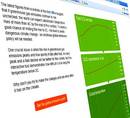The IPCC
The International Panel on Climate Change was formed to summarise and integrate all of the latest findings and predictions, to inform world leaders as they make decisions on what to do in response to global climate change. The last IPCC report was in 2007 and predicted severe effects, such as a probable rise in global temperatures of between 2 and 4oC and a possible rise of up to 6.5oC, and rising sea levels of between 28 and 43cm.
The latest estimates for climate change
The next IPCC report isn't due until 2013. However a group of 26 climate scientists tried to update the 2007 report using data from the hundreds of scientific papers published since then. Their findings were released just before the Copenhagen Climate Summit in Dec 2009.
 The Copenhagen Diagnosis report
The Copenhagen Diagnosis report covers:
Greenhouse gas emissions:
Global CO2 emissions in 2008 were 40% higher than those in 1990. Even at present–day levels, just 20 more years of emissions at this rate would give a 25% probability (1 chance in 4) that warming exceeds 2oC.
Global temperatures:
Over the past 25 years temperatures have increased at a rate of 0.19 oC per decade, in very good agreement with scientists' predictions based on greenhouse gas increases.
Melting ice:
Satellite and ice measurements show that both the Greenland and Antarctic ice-sheets are losing ice mass at an increasing rate. Melting of glaciers and ice-caps in other parts of the world has also accelerated since 1990.
Rapid Arctic sea-ice decline:
Summer-time melting of Arctic sea-ice has accelerated far beyond predictions. The area of summertime sea-ice during 2007-2009 was about 40% less than the average prediction from IPCC 1997 models.
Sea-level rise:
Satellites show a great global average sea-level rise (3.4mm per year) that is 80% above past IPCC predictions. This acceleration in sea-level rise is consistent with a doubling in water contribution from the melting of glaciers, ice caps and the Greenland and West-Antarctic ice-sheets.
Sea-level prediction revised:
By 2100, global sea-level is likely to rise at least twice as much as predicted in 1997. If emissions do not stop, this may well be between 1-2m by 2100. Sea-level will continue to rise for centuries after global temperature have been stabilized and several metres of sea level rise must be expected over the next few centuries.
Delay in action risks irreversible damage:
Several vulnerable parts of the world climate could be pushed towards abrupt or irreversible change if warming continues as it is currently doing. These include the north, south polar and Greenland ice-sheets, Amazon rainforest, West African monsoon and others. The risk of passing critical thresholds (“tipping points”) increase strongly with ongoing climate change. Waiting for higher levels of scientific certainty before acting to stop climate change could mean that some tipping points will be crossed before they are recognized.

Conclusion: Action to stop further climate change must come very soon:
For global warming to be kept below 2oC, the increase in global greenhouse emissions must stop by 2015 to 2020 and then decline rapidly. To stabilise the climate, all humanity will need to move to living with near-zero greenhouse gas emissions well within this century. The average annual emissions per-person will have to shrink to well under 1 ton of CO2 by 2050. This is 80-90% below the emissions levels of developed nations in 2000.
 Source materials for this page
Source materials for this page
 Uncertainty and probability in climate predictions
Uncertainty and probability in climate predictions








 Climate scepticism: The top 10
Climate scepticism: The top 10 Scepticism and the scientific process
Scepticism and the scientific process
What's your opinion?
Average rating




Not yet rated